Moira Butterfield's Blog, page 40
February 14, 2018
World Book Day Treasure Hunt • Jonathan Emmett

Last year's Picture Book Den post on how to organise a " Picture Book World Cup " in schools got such a good response that I thought I'd follow up with a similar post on how to run a Picture Book Treasure Hunt.
Like the Picture Book World Cup, this is an activity that I originally ran with my former Patron of Reading school, Asfordby Captain's Close Primary in Leicestershire. We did our treasure hunts in June, which meant we were able to run them outside, in the school grounds, but a hunt would work just as well inside. And it would make an ideal book-themed activity for the upcoming World Book Day, which is why I'm blogging about it now!
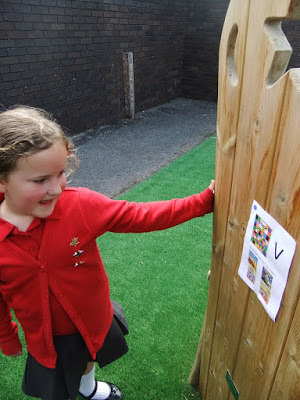 A Captain's Close student discovers one of the question sheets.
A Captain's Close student discovers one of the question sheets.We ran two separate treasure hunts: a picture book themed hunt for Key Stage 1 and a novel themed hunt for Key Stage 2. I'm going to describe how to run the KS1 picture book version, but the KS2 version works in a similar way and you can find information on it and links to download packs for both versions at the bottom of this post.
How the hunt worksThe hunt is a race against time. The first student to complete it correctly wins. A winner's certificate is included in the download pack, but schools may want to offer a book as a prize as well.
Once they have completed the hunt, students will need to hand in their answer slip to a Hunt Collector (a nominated member of staff), so make sure all the students know who the Hunt Collector is and where they can be found before the hunt starts.
If the hunts we ran are anything to go by, the winner is more likely to be a tortoise than a hare. Make it clear that the winner is the first student to hand in a CORRECTLY COMPLETED answer slip. The twentieth student to hand in their slip could still be the winner if the previous nineteen have not completed the hunt correctly!
It will take a little time to check the answer slips, so let the students know when the winner will be announced. If you're running the hunt in the morning, you might tell the students that the winner will be announced in an afternoon assembly.
The hunt uses a set of ten multiple choice question sheets like this one:
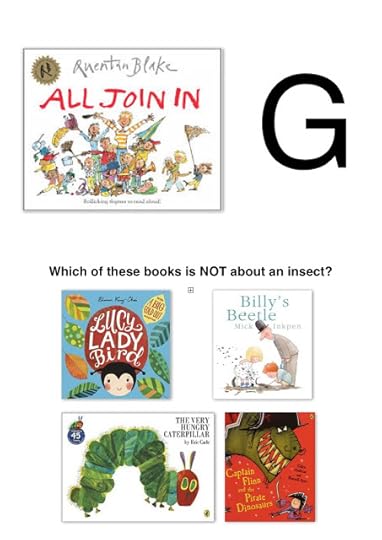
The question sheets are stuck up in different locations around the whole of the school. Before the hunt starts, make sure students know where they can and where they cannot look.
Students all start the hunt at the same time, but in any place, with any sheet. It makes sense to split students up as much as possible at the start so they begin in lots of different locations. That way, they will not all be looking for the same question sheet at the same time.
Each student is given an answer slip like this:

When a student finds their first sheet, they write down the big letter at the top in the first square of their answer slip. Then they read the question and decide which of the four book covers at the bottom of the sheet is the correct answer. Then the student has to find another sheet that has that book cover at the top and repeat the same process.
Students should be able to answer the questions in the KS1 hunt in the download pack by looking at the books' covers. Remind students that if they have a problem reading or understanding a question, they can ask a teacher for help.
As students search for the question sheet with the correct cover, they will probably spot other question sheets that they will need to find later on in the hunt, so students should try to remember where each sheet is, even if it's not the one they're currently looking for.
When a question leads a student back to the question sheet they began with, they should have a letter in each of the 10 boxes. They have now finished the hunt and should hand in their answer slip to the Hunt Collector straight away!
The first student to hand in a correctly completed answer slip to the Hunt Collector wins.
Tips for the organisersExample question sheet: Before starting the hunt, use the example question sheet in the download pack to explain how the hunt works and what students have to do.
Synchronise the start: Agree an exact start time for the hunt, then split the students into small groups and ask a member of staff to accompany each group to a different part of the school to start the students at that time.
Leave time to find the winner: If the hunt we ran is anything to go by, the first students to hand in their slips will have got their letters in the wrong order and you will have to check through several incorrectly completed slips before finding a correctly completed winner.
When you announce the winner (preferably in an assembly), you might want to spread the credit and heighten the tension by revealing the top three hunters in reverse order. If the school is feeling generous, they could give a prize to the runners-up too.
Tips for the Hunt CollectorDon't worry about marking the answer slips as they come in! The important thing is to keep a record of the order you receive them. So write a number in the top box in the top right corner of each slip as it is given to you.
The first few students to give you their answer slips will probably have filled them in incorrectly, so keep collecting the slips and recording the order you receive them in until you've collected them all or until the time programmed for the hunt is over.
Once you've collected all the answer slips, you can use the long marking strip in the download pack to check the sequence on each slip quickly. Starting with the first answer slip to be handed in, line up the first letter on the slip with the first occurrence of the same letter on the marking strip. If the student has completed the hunt in the right order all of the following letters will match those on the marking strip.
 Use the long marking strip to check the sequence quickly, by lining up the first letter on the student's sheet with the same letter's first appearance on the strip.
Use the long marking strip to check the sequence quickly, by lining up the first letter on the student's sheet with the same letter's first appearance on the strip.If the sequence of letters on the first slips you check don't match the sequence on the marking strip exactly, put a cross where the sequence is broken. It's worth keeping rejected slips in the order they were collected in as, in the event that no student gets the whole sequence right, you will need to go back through the slips and pick out a winner with the longest correct sequence.
Once you've found the winner you can fill out the certificate in the download pack and present it to them.
Foundation and Reception Simplified OptionFoundation and reception students can do an easier version of the hunt by simply finding all the question sheets and writing down all the letters. The winner is the first student to hand in a slip with all the correct letters in any order.
Hunt the Teacher OptionThe download pack contains an off the peg version of the hunt that will work in any school. However, the original hunts we ran included extra questions about teachers' favourite books, as shown in the example below.
 Additional Hunt the Teacher question sheets like this get
Additional Hunt the Teacher question sheets like this getstudents talking to teachers about their favourite books.
To answer this question, students had to find the teacher and ask them which book was their favourite. This was a good way to show children that grown-ups enjoy reading and to get the students talking to staff about their choices. If you want to create your own version of the hunt using this option, you will need to ask staff to name their favourite books in advance so they can be written into the hunt. And if a staff member is unexpectedly away on the day (as was the case with one of our hunts), make sure another staff member knows the correct answer and that the students know who this is before they start the hunt.
Key Stage 2 VersionA download pack for an off the peg Key Stage 2 version featuring children's novels is also available below. This runs in exactly the same way as the KS1 version, but has the following tweaks to make it a little more difficult:
There are 15 questions instead of 10.While the answers to some questions can be found by looking at the covers, others require a little knowledge of the books.On some question sheets, more than one of the covers at the bottom of the sheet can be found at the top of other sheets, so students can't just go looking for any of the four options like they can in the KS1 hunt - they need to find the sheet with the correct cover to get the correct sequence of letters. If students get back to the sheet they started with and haven’t got a letter in all 15 of the boxes, they will probably have skipped a few letters by answering a question incorrectly.
And of course, you can create your own KS2 hunt with some hunt the teacher question sheets just like the ones described for the KS1 version above.
Click on an image below to download a Treasure Hunt pack as a zip file.
Key Stage 1
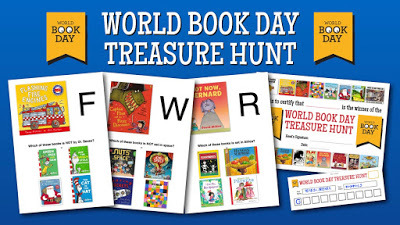
Key Stage 2
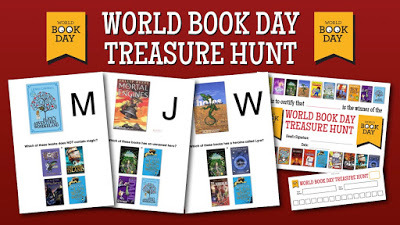
For some more ideas for activities your school can do to celebrate World Book Day,check out this page on Jo Cotterill's blog.
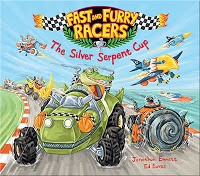 For an exciting picture book race against time, check out Jonathan's rhyming romp
The Silver Serpent Cup
, illustrated by Ed Eaves, and published by Oxford University Press.
For an exciting picture book race against time, check out Jonathan's rhyming romp
The Silver Serpent Cup
, illustrated by Ed Eaves, and published by Oxford University Press.Find out more about Jonathan and his books at his Scribble Street web site or his blog. You can also follow Jonathan on Facebook and Twitter @scribblestreet.
See all of Jonathan's posts for Picture Book Den.
Published on February 14, 2018 01:49
February 4, 2018
Inclusive Indie Publishers by Chitra Soundar
In the last few years, there has been a positive trend of many independent publishing houses being setup and many of them are inclusive and diverse. While some focus on publishing stories from around the world, others bring work of translation into the UK. And in some cases, new houses are focussing on specific cultures that are under-represented in the UK.
My picture books in the UK are published by two indie houses that support cultural diversity and it is great to know that there are more publishers whose mission is to bring the world to the children here in the UK.
Here is a list I put together based on my own un-scientific research. If you know of any others, please leave their names in the comment section.
I’ll start with the three publishers I’ve worked with:
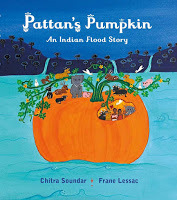
Otter-Barry Books – Janetta Otter-Barry published both poetry and inclusive books as a publisher at Frances Lincoln and her new venture carries on that tradition with beautiful books for today’s world.
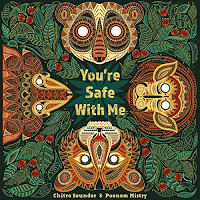 Lantana Publishing – In their own words, “Lantana Publishing is hugely proud to bring UK children’s publishing one step closer towards achieving a more diverse and inclusive children’s book landscape for the next generation of young readers.”
Lantana Publishing – In their own words, “Lantana Publishing is hugely proud to bring UK children’s publishing one step closer towards achieving a more diverse and inclusive children’s book landscape for the next generation of young readers.”
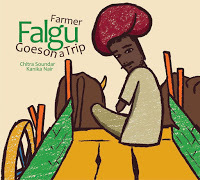 Red Robin Books – while Red Robin Books were originally setup to produce and promote books by Neil Griffiths, they also now produce books by other authors and illustrators. I’m proud to say my Farmer Falgu series have been adopted by Red Robin Books in the UK.
Red Robin Books – while Red Robin Books were originally setup to produce and promote books by Neil Griffiths, they also now produce books by other authors and illustrators. I’m proud to say my Farmer Falgu series have been adopted by Red Robin Books in the UK.
I haven't worked with the publishers listed below, but I've heard wonderful things about them.
Tiny Owl Books – The books they publish…”give children unique perspectives on universal themes such as love, friendship and freedom and a greater awareness of the diverse and colourful world we live in.”
FireTree Books – Verna Wilkins is back and she has renewed her commitment to inclusive books at her latest venture FireTree Books. Her first publishing house Tamarind Books is now part of Random House and continue on their mission too.
Book Island – this publisher brings books from other languages into the UK. Read here about why more translated books are important for the children in the UK
The next two publishers focus on a specific cultural heritage - African and Chinese respectively.
African Parrot – is a publisher based in Edinburgh who want to promote positive images about Africa to children across the world.
Snowflake Books is a joint venture between Taiwan and British experts to bring Chinese stories to the UK
Darf Publishers and Pushkin Children’s produce a number of children’s titles from writers and illustrators across the world, though their main focus is fiction.
Sweet Apple Books also publish inclusive children’s books.
And slightly venturing outside the island, here are some publishers with similar missions.
Yali Books, NY who promote stories from South Asia
Golden Baobab & African Bureau for Children’s Stories is a non-profit organisation based in Ghana, whose vision is to inspire the imaginations of African children through African stories.
Groundwood Books, Canada who are particularly committed to publishing books for and about children whose experiences of the world are under-represented elsewhere.
So if you’re a parent who is looking for diverse picture books for your children or a teacher who wants to have an inclusive bookshelf or a writer/illustrator who is looking for inclusive publishers, do check these publishers out.
If you have suggestions for other publishers, especially indie, who are committed to an inclusive list, do leave their names in the comment section.
Chitra Soundar is a writer made into an author by indie publishers. From her picture books in India to the ones in the UK, she works with wonderful publishers whose passion for inclusive books is infectious. Find out more at www.chitrasoundar.com or follow her on Twitter at @csoundar.
My picture books in the UK are published by two indie houses that support cultural diversity and it is great to know that there are more publishers whose mission is to bring the world to the children here in the UK.
Here is a list I put together based on my own un-scientific research. If you know of any others, please leave their names in the comment section.
I’ll start with the three publishers I’ve worked with:

Otter-Barry Books – Janetta Otter-Barry published both poetry and inclusive books as a publisher at Frances Lincoln and her new venture carries on that tradition with beautiful books for today’s world.
 Lantana Publishing – In their own words, “Lantana Publishing is hugely proud to bring UK children’s publishing one step closer towards achieving a more diverse and inclusive children’s book landscape for the next generation of young readers.”
Lantana Publishing – In their own words, “Lantana Publishing is hugely proud to bring UK children’s publishing one step closer towards achieving a more diverse and inclusive children’s book landscape for the next generation of young readers.” Red Robin Books – while Red Robin Books were originally setup to produce and promote books by Neil Griffiths, they also now produce books by other authors and illustrators. I’m proud to say my Farmer Falgu series have been adopted by Red Robin Books in the UK.
Red Robin Books – while Red Robin Books were originally setup to produce and promote books by Neil Griffiths, they also now produce books by other authors and illustrators. I’m proud to say my Farmer Falgu series have been adopted by Red Robin Books in the UK.I haven't worked with the publishers listed below, but I've heard wonderful things about them.
Tiny Owl Books – The books they publish…”give children unique perspectives on universal themes such as love, friendship and freedom and a greater awareness of the diverse and colourful world we live in.”
FireTree Books – Verna Wilkins is back and she has renewed her commitment to inclusive books at her latest venture FireTree Books. Her first publishing house Tamarind Books is now part of Random House and continue on their mission too.
Book Island – this publisher brings books from other languages into the UK. Read here about why more translated books are important for the children in the UK
The next two publishers focus on a specific cultural heritage - African and Chinese respectively.
African Parrot – is a publisher based in Edinburgh who want to promote positive images about Africa to children across the world.
Snowflake Books is a joint venture between Taiwan and British experts to bring Chinese stories to the UK
Darf Publishers and Pushkin Children’s produce a number of children’s titles from writers and illustrators across the world, though their main focus is fiction.
Sweet Apple Books also publish inclusive children’s books.
And slightly venturing outside the island, here are some publishers with similar missions.
Yali Books, NY who promote stories from South Asia
Golden Baobab & African Bureau for Children’s Stories is a non-profit organisation based in Ghana, whose vision is to inspire the imaginations of African children through African stories.
Groundwood Books, Canada who are particularly committed to publishing books for and about children whose experiences of the world are under-represented elsewhere.
So if you’re a parent who is looking for diverse picture books for your children or a teacher who wants to have an inclusive bookshelf or a writer/illustrator who is looking for inclusive publishers, do check these publishers out.
If you have suggestions for other publishers, especially indie, who are committed to an inclusive list, do leave their names in the comment section.
Chitra Soundar is a writer made into an author by indie publishers. From her picture books in India to the ones in the UK, she works with wonderful publishers whose passion for inclusive books is infectious. Find out more at www.chitrasoundar.com or follow her on Twitter at @csoundar.
Published on February 04, 2018 23:00
January 28, 2018
Bogey Bum Burp Fart Snot Belch and Poo by Garry Parsons
It’s winter and the weather is pretty miserable outside. It’s dark when you wake up and dark before the afternoon is out. The joys of Christmas are a long way off and there have been more than a couple of days in the past few weeks where I haven’t left the house at all except to fetch milk from the doorstep.
At least we have passed the third Monday of the year, which, according to some media, is officially the UK’s most cheerless day in the calendar and we are no longer in the middle of January but right at the end, which is almost February, a comparatively short month anyway, which leads into March when things start growing in the garden, the clocks change, eggs hatch, birds sing and it’s SPRING!
So I had thought this post would be about picture books that look at the optimistic joys of Spring!
 "I Am A Bunny" By Richard Scarry
"I Am A Bunny" By Richard ScarryA closer inspection revealed that Spring in the UK doesn’t start officially until March 20th and the clocks don't change for another five days after that. That’s fifty days away from now…fifty!
So this blog is now about bogies, smells, toilets, mess, farts and poo. Spring can wait.
When I look back over my career as an illustrator and scan the variety of books I’ve had the pleasure to work on and all the brilliant and wonderful authors I’ve worked with, I can’t help but notice that there is a lot of mess of one form or another recurring throughout.
 "The Dinosaurs Are Having A Party!" By Gareth P Jones & Garry Parsons
"The Dinosaurs Are Having A Party!" By Gareth P Jones & Garry ParsonsI am far from alone in the picture book world in creating a mess of one sort or another but there does seem to be a lot of it on my shelves. And I sometimes get a look of disdain from adults about the Dinosaur that Pooped books I have illustrated, despite their popularity, because of the poo content.
 "The Dinosaur That Pooped The Bed" By Tom Fletcher, Dougie Pointer & Garry Parsons
"The Dinosaur That Pooped The Bed" By Tom Fletcher, Dougie Pointer & Garry ParsonsSo my intention here is to celebrate the tradition of the ‘disgusting’ and ‘gross’ in children’s books a little, because it is an area that has been around for a long time and has a unique place in picture books and early years fiction.
 "Fungus the Bogeyman" By Raymond Briggs
"Fungus the Bogeyman" By Raymond BriggsThere is the slime-drinking Fungus The Bogeyman, or the batty old woman who swallowed a fly and proceeded to consume the rest of the farmyard, and who hasn’t enjoyed the shortsighted Mole’s journey to discover who did the dirty on his head in The Story of the Little Mole Who Knew It Was None of His Business?
 "The Story of the Little Mole who knew it was None of his Business" by Werner Holzwarth & Wolf Erlbruch
"The Story of the Little Mole who knew it was None of his Business" by Werner Holzwarth & Wolf ErlbruchSo what is it about pirates in underpants, stinky cheese smells and animal business that kids find so amusing and why is it that some adults turn their noses up at books like these?
 "The Dinosaur That Pooped A Planet" By Tome Fletcher, Dougie Pointer & Garry Parsons
"The Dinosaur That Pooped A Planet" By Tome Fletcher, Dougie Pointer & Garry ParsonsMy youngest son, just turned a mighty five and a lover of all things disgusting and someone who finds saying a sentence without the inclusion of poo, bum or fart virtually impossible, told me:
"Errm, poo books are naughty and stinky and dinky"And what's your favourite part about them?"Poo."
 "Hey! What's That Nasty Whiff?" By Julia Jarman & Garry Parsons
"Hey! What's That Nasty Whiff?" By Julia Jarman & Garry ParsonsI admit, some topics might lack a bit of culture for the adult reader, and let’s face it, poop and bogeys will never be particularly highbrow material (too sticky perhaps), but the unmentionable and unthinkable in books for kids can often be an outlet for behaviour that wouldn’t be funny in real life, but that is very, very, very funny to imagine doing through books. Nothing is more satisfying that seeing other people, characters or animals break the rules of good etiquette. Varp!
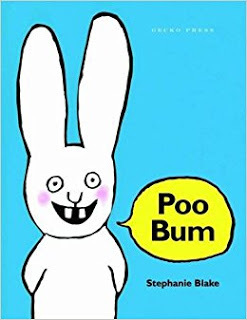 "Poo Bum" By Stephanie Blake
"Poo Bum" By Stephanie BlakeOn a literacy level, we could also argue that the gross humour might well be a gateway into getting kids reading more and I for one have had feedback from parents that confirms this.
 "Morris The Mankiest Monster" By Giles Andreae & Sarah McIntyre
"Morris The Mankiest Monster" By Giles Andreae & Sarah McIntyreOne gross but funny book moment that has embossed itself on my memory is a scene from Daisy and the Trouble with Zoos where Daisy and her friends are taken to the zoo for a birthday treat but instead are treated to something every zoo visitor has enjoyed…or maybe not.

 "Daisy and the Trouble With Zoos" By Kes Gray, Nick Sharratt & Garry Parsons
"Daisy and the Trouble With Zoos" By Kes Gray, Nick Sharratt & Garry ParsonsSo with this image in mind I rang Kes Gray for his thoughts on disgusting themes in kids books and he told me:
"Words are the glue that hold every story together. The more words a child reads the more confident a reader they will become. Reluctant readers wade through the glue. Given the right encouragement they will skip through it.Stories with a frisson of naughtiness can carry a child a very long way. Bogies, bums, boobies, poo, snot, farts, burps and belches may have no place at the dinner table but in a quiet corner of the classroom, at the comfy end of the sofa or under the bedcovers by torchlight they can be just the kick start an early reader needs."
(Actually, most of those do occur at our dinner table! Ask my youngest.)
 "Hey! What's That Nasty Whiff?" By Julia Jarman & Garry Parsons So there you go. If you are feeling sniffy about reading picture books about burps, farts, bogies, poo, bums or snot, take a moment to remember yourself aged five and three-quarters and the unmentionable things that had you doubled over in the library, or clutching your stomach with laughter on a cold afternoon in January.
"Hey! What's That Nasty Whiff?" By Julia Jarman & Garry Parsons So there you go. If you are feeling sniffy about reading picture books about burps, farts, bogies, poo, bums or snot, take a moment to remember yourself aged five and three-quarters and the unmentionable things that had you doubled over in the library, or clutching your stomach with laughter on a cold afternoon in January.And in the tradition of naughtiness, here is a joke that my son claims he made up himself:Why did the underpants go down the stairs?To get to the bottom!
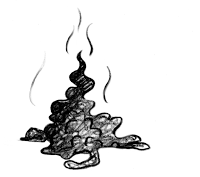
Reading lists;
My son’s disgusting reading recommendations…Here Comes The Poo Bus by Andy Stanton & Noëlle Davies-Brock – Puffin 2011Poo Bum by Stephanie Blake – Gecko Press 2013The Great Dog Bottom Swap by Peter Bently & Mei Matsuoka – Andersen Press 2010
My smelly reading recommendations…The Stinky Cheese Man and other Fairly Stupid Tales by Jon Scieszka & Lane Smith – Viking 1992The Story of the Little Mole who knew it was None of his Business by Werner Holzwarth & Wolf Erlbruch – David Bennet Books 1989There Was An Old Lady Who Swallowed A Fly created by Jeremy Holmes – Chronicle Books 2008.
My thanks to Kes Gray for his thoughts. Kes is the author the hugely successful “Oi” series with illustrator Jim Field, and the bestselling DAISY books, including the award-winning Eat Your Peas and Billy’s Bucket, winner of the Red House Children's Book Award for Younger Readers. His website is brilliant.
Garry Parsons is the illustrator of the best selling Dinosaur That Pooped series of pictures books by Tom Fletcher & Dougie Poynter. Garry is alsothe illustrator of the recently published Happy Easter Toothfairy, written by Peter Bently (Hodder), which he was going to mention earlier when the blog was about Spring.@icandrawdinos
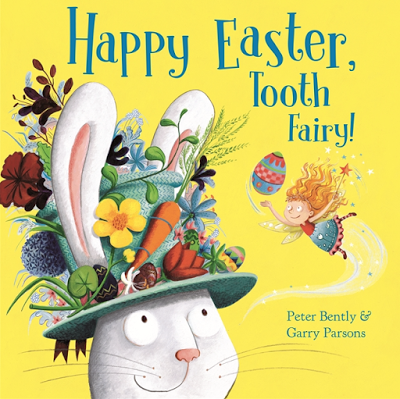
Published on January 28, 2018 14:22
January 21, 2018
'Little Red Reading Hood'- a 'Q and A' with illustrator Ben Mantle, by Lucy Rowland.
For the last post of 2017, the Picture Book Den team put together a joint blog titled 'Our picture books, our favourites' where authors and illustrators shared their favourite self-penned or self-drawn picture books. You can find the link here: http://picturebookden.blogspot.co.uk/2017/
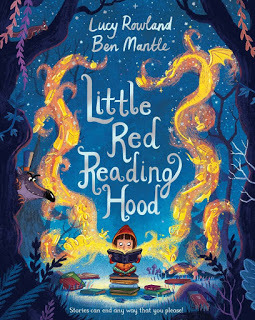
I chose 'Little Red Reading Hood', mine and Ben Mantle's upcoming picture book with Macmillan. For me, 'Little Red Reading Hood' is a celebration of libraries, reading, story and the power of imagination. I believed in the text from the start but it's the illustrations that have really brought it to life with such magic!

The incredibly talented Ben Mantle has a background in animation as well as children's book illustration and he has kindly agreed to take time out of his busy schedule to answer some questions about his work and artistic process. Thank you, Ben!
1) You are now a very well established illustrator, with self-penned picture books as well as books that you have collaborated on with other authors. Which projects do you generally prefer to work on?
This will seem like a cop-out, but it is absolutely true, I really enjoy both to be honest and couldn’t pick between them. Working on your own authored book is special because its your baby, and you get to birth it and see it grow. It’s a lot of hard work figuring it out and writing doesn’t come naturally to me. But, when you get it right, it feels great! However, I love being sent a brilliant story and being able to jump straight in. To read it through and enjoy it like the reader will. Plus, I love adding something new to the story, to my own spin on a book. Both are really team efforts and I really enjoy the variety and the different challenges that come with them.
2) If you are collaborating on a book, what is it about a text that makes you want to illustrate it? Was there anything in particular about Little Red Reading Hood that made you want to take it on?
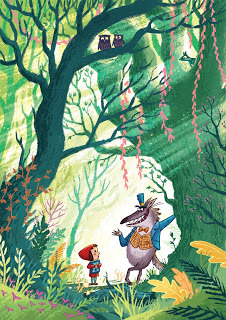 I guess there are many reasons. I can tell on the first read if it is something I want to work on. Sometimes it’s the characters or the setting that make me want to work on a book or a funny/witty text. It’s also important to me that the text has room to allow me to add something myself, rather than being told exactly what should be on every page. With Little Red Reading Hood it was all of those. The Big bad wolf is a character that I’ve always wanted to draw and I really loved the idea of illustrating the woods that Little Red ventures into. The text zipped along at such a pace and made me laugh out loud, which is rare! Any book with line– “What a Barbarian! Wolf had tied up Mrs Jones the Librarian!” is a book that I want to work on.
I guess there are many reasons. I can tell on the first read if it is something I want to work on. Sometimes it’s the characters or the setting that make me want to work on a book or a funny/witty text. It’s also important to me that the text has room to allow me to add something myself, rather than being told exactly what should be on every page. With Little Red Reading Hood it was all of those. The Big bad wolf is a character that I’ve always wanted to draw and I really loved the idea of illustrating the woods that Little Red ventures into. The text zipped along at such a pace and made me laugh out loud, which is rare! Any book with line– “What a Barbarian! Wolf had tied up Mrs Jones the Librarian!” is a book that I want to work on. 3) You used to be an animator, how do you feel that this has influenced your illustration work?
It has definitely had a big impact. The artists that I really look up to are mostly from the Animation world. Disney artists Mary Blair is so good with colours and mood and Gustaf Tenggren whose work on Pinocchio, I just adore. I would also put Raymond Briggs, Bill Watterson and Hayao Miyazaki in the list too. The skills you pick up working on Animation are invaluable too. Thinking about character, world building, pacing, storyboarding, not to mention the observation skills that really help with posing and composition. I generally can tell an ex-animator in publishing because of these skills.
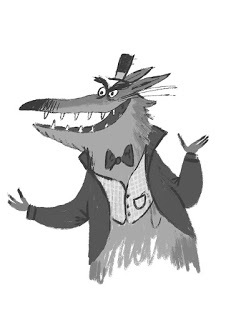
4) Could you tell us a bit about your typical working day as an illustrator?
My working week changes depending on what I’m doing and how busy I am. It’s something close to 9-6 in the studio and then a few hours in the evenings sketching or planning. I’m often working on several things at a time, so you have to be good at managing your time and be able to swap projects easily. My studio in the lovely North Laines of Brighton, surrounded by lots of pubs and cafes. I share the place with a whole bunch of other ‘creatives’. In fact, there’s now 3 of us who all work in Children’s publishing in one way or another, which is very nice. I tried working at home, which I know a lot of illustrators do, but I started to go crazy. I’ll either be working on my Cintiq (think large screen that you can draw directly on to) or at my drawing board, which I use to trace my rough drawings using either paint or pastel.
5) Fairytales and twists on fairytales have been told and re-imagined many times. Is it difficult to approach a familiar story in a new way or do you see this as an exciting challenge?
It is both to be honest. You have a pre-conceived idea of what that world and its characters look like, which is helpful to some degree. It’s like thousands of illustrators have built a nice foundation for you to start. So you need to follow certain conventions so that it has some link to the original, but it often means spending more time finding your own unique take on it. But that is also the fun! You get to break the rules and surprise people. That’s why I’m known as Ben ‘rule breaker’ Mantle.
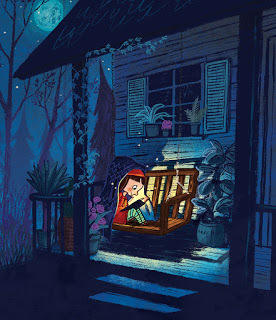
6) If you could illustrate and re-imagine any fairy tale, which would you choose?
Oh, now that is tricky! I’d be tempted to go with something dark. You don’t get much chance in picture books to do that. A proper Brothers Grimm, with nothing softened. Maybe, Hansel and Gretel. When I was a kid I had a version of the Beowulf, that I genuinely found the pictures in it terrifying. But, that was what made it so good, it was the anticipation of turning the page to something that creeped me out. I’m not sure if you would class it as a fairy tale, but Alice in Wonderland would be real fun too. It chock full of brilliant, eccentric characters and already has that gothic darkness that would appeal to me.
7) If you were a fairy tale character, who would you be?
Erm…I’d choose one of them that doesn’t get cooked or murdered. Who does that leave me with? Maybe a background character. Tim the blacksmith in Hansel and Gretel. Never heard of him? Well, that’s because I made him up, but he lives a very quiet, idyllic life and never meets a witch or wolf or a beast of any kind. Okay, at a push, and if you’ll agree that he’s a fairytale character I’d go for Peter Pan. He never grows up and has to pay bills and he can fly! And looks great in leggings!
8) What is next on the horizon for you?
I’m working on some great projects at the moment, but I can’t really say much about them. But I am working on some new text ideas of my own, which I’m hoping to find time to work on next year. And of course, I’ll be working on our next book together, which is another brilliant rhyming text may I say. I guess you wouldn’t call it a fairytale per se, but it definitely riffs off classic characters and settings. And, actually it’s funny that I said I would like to illustrate something gothic before, because although our next book is light in tone, the setting is darker. But that is what drew me to it, that the characters bring real colour and light to the book and I can’t wait to illustrate that contrast.
Thank you Ben! You can learn more about Ben's beautiful work on his website http://www.benmantle.co.uk/And you can keep up with all his news by following him on twitter @BenMMantle or Instagram benmmantle
Published on January 21, 2018 22:30
January 14, 2018
Where voice comes from by Jane Clarke
People speak about picture book writer having a 'voice.' It's a tricky thing to pin down. The voice of the writer helps create the tone and the mood of the book - but a huge part of that is down to the illustrator. If the writer's text gets taken for publication, a good editor will match the voice of the writer with an illustrators voice, so that both voices complement one another.
For me, voice is what comes naturally - my writer's voice is a reflection of the way I speak. In my head, my characters talk, I try to make their voices distinct, but they are part of my life experience. I can identify three main sources of my picture book writing voice:
The voice of the child...
in me
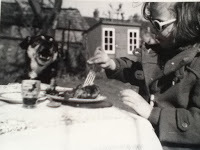 I shared everything with my dog and my sons' voices when they were small.
I shared everything with my dog and my sons' voices when they were small.
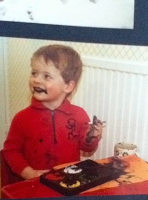
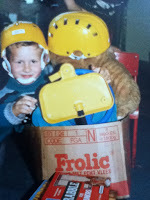
The parental voice
I can still hear my mum and dad's' voices
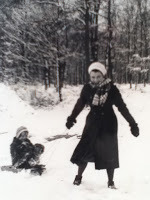
 I was an only child ( my dog was my brother) and had a brilliantly happy childhood.
I was an only child ( my dog was my brother) and had a brilliantly happy childhood.
and the voices of the parents my late husband and I were to our sons
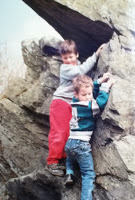 Always ready to catch!
Always ready to catch!
Then there's the voices of pets, and there's been a lot of them over the years - from stick insects, snakes, bearded dragons, mice, hamsters, guinea pigs, rabbits to cats and dogs.
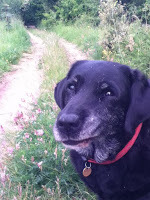 Bramble was particularly expressive!
Bramble was particularly expressive!
Recently, I've found a fourth voice is creeping into my writing - my grandparental voice, acquired with the arrival of 4 granddaughters in 3 years.
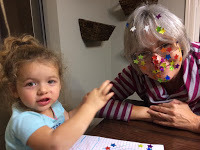

And as my granddaughters get older, I'll be excited to add their voices to my voice, too!
On the few occasions when I've tried to modify my voice, for example as follow-up writer on a ghost-written series, I've found it really difficult When I use my voice writing picture books, the texts feel like a part of me. I guess that's what makes it so hard when they get rejected!
Where does your writing or illustrating voice come from?
Jane's most recent picture book, Firefly Home, glimmeringly illustrated by Britta Teckentrup, published in the UK, 11 January 2018 - and all of her voices are in it :-)
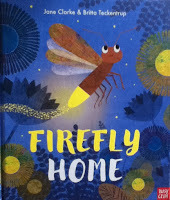 Very special to Jane who watched fireflies with her sons and their families when they shared a holiday at Lake Lure, NC.
Very special to Jane who watched fireflies with her sons and their families when they shared a holiday at Lake Lure, NC.
For me, voice is what comes naturally - my writer's voice is a reflection of the way I speak. In my head, my characters talk, I try to make their voices distinct, but they are part of my life experience. I can identify three main sources of my picture book writing voice:
The voice of the child...
in me
 I shared everything with my dog and my sons' voices when they were small.
I shared everything with my dog and my sons' voices when they were small.

The parental voice
I can still hear my mum and dad's' voices

 I was an only child ( my dog was my brother) and had a brilliantly happy childhood.
I was an only child ( my dog was my brother) and had a brilliantly happy childhood.and the voices of the parents my late husband and I were to our sons
 Always ready to catch!
Always ready to catch!Then there's the voices of pets, and there's been a lot of them over the years - from stick insects, snakes, bearded dragons, mice, hamsters, guinea pigs, rabbits to cats and dogs.
 Bramble was particularly expressive!
Bramble was particularly expressive!Recently, I've found a fourth voice is creeping into my writing - my grandparental voice, acquired with the arrival of 4 granddaughters in 3 years.


And as my granddaughters get older, I'll be excited to add their voices to my voice, too!
On the few occasions when I've tried to modify my voice, for example as follow-up writer on a ghost-written series, I've found it really difficult When I use my voice writing picture books, the texts feel like a part of me. I guess that's what makes it so hard when they get rejected!
Where does your writing or illustrating voice come from?
Jane's most recent picture book, Firefly Home, glimmeringly illustrated by Britta Teckentrup, published in the UK, 11 January 2018 - and all of her voices are in it :-)
 Very special to Jane who watched fireflies with her sons and their families when they shared a holiday at Lake Lure, NC.
Very special to Jane who watched fireflies with her sons and their families when they shared a holiday at Lake Lure, NC.
Published on January 14, 2018 22:00
January 7, 2018
How would you end this story? • Francesca Sanna (guest blogger)
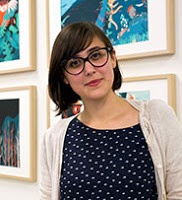 The Picture Book Den welcomes guest blogger, Francesca Sanna. Her first picture book, The Journey, received wide acclaim and is endorsed by Amnesty International UK for reminding us that we all have the right to a safe place to live. Francesca's many awards include the 2017 Klaus Flugge Prize, which is presented to the year's most promising and exciting newcomer to children’s picture book illustration.
The Picture Book Den welcomes guest blogger, Francesca Sanna. Her first picture book, The Journey, received wide acclaim and is endorsed by Amnesty International UK for reminding us that we all have the right to a safe place to live. Francesca's many awards include the 2017 Klaus Flugge Prize, which is presented to the year's most promising and exciting newcomer to children’s picture book illustration. In this blog post, Francesca talks about the debate surrounding the ending to The Journey.
My first book, The Journey, is the story of a family and of the journey they undertake when they realise their home is not a safe place anymore. As I briefly tried to explain in a note at the end of the book, it was inspired by many stories of many people I spoke with, from many different countries and backgrounds. A part of the research was even focused on historical documents about immigration in the early 1900. I didn’t want The Journey to be a specific story; I wanted it to convey the idea that everyone has to right to have a safe place to live. For this reason, in the book I try to give as little information as possible about where, or when, the story is set.
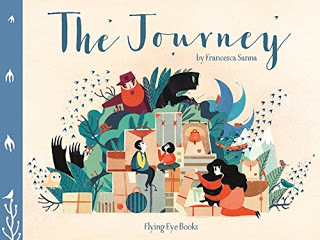 The Journey by Francesca Sanna, Flying Eye Books 2016
The Journey by Francesca Sanna, Flying Eye Books 2016A few months ago, during a reading with Year Two children in a school in London, a boy asked me, “How do you end a book that is inspired by a real story if that story is still going on?”
Questions are always a challenge, and I love the process of thinking about them and trying to come up with good answers – though I often fail – but I found this one particularly interesting. It made me think about another question I get asked quite often, mostly from adults: “Why does The Journey not have a proper ending?” The story I wrote does in fact have an ending, but it is a quite open one. The journey of the family we follow through the pages is not concluded in the usual way. Instead, the book ends leaving the family on their way to a new home, without showing any arrival, and this element has caused much discussion. Someone during a conference even told me I had cheated as I had gone against one of the main rules in children’s literature: a children’s book needs a happy ending.
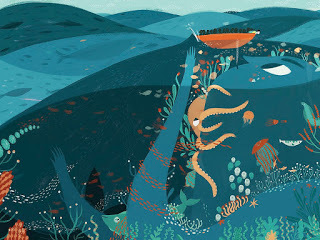 Journeying on the ferry, from The Journey by Francesca Sanna
Journeying on the ferry, from The Journey by Francesca SannaA couple of years before I finished the book, I decided to do some research around the topic of immigration and in particular of refugees, because of what was happening (and sadly still is happening) in Italy, my home country, and in the rest of Europe. I was quite frustrated by having the same discussion over and over with people I knew, and by reading the comment sections of many posts on social media. In Italy the public opinion was – and still is – increasingly becoming more intolerant and turning against newcomers. When I first moved to study and work in other European countries (Germany first and then Switzerland) I saw that the same discussion and attitude was spreading there too.
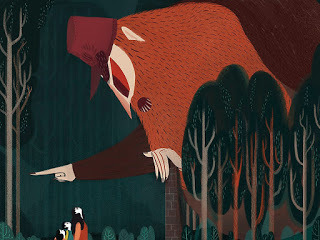 Border guard, from The Journey by Francesca SannI finished the illustrations for The Journey in May 2015, right before one of the worst moments of the refugee crisis in Europe. After that I was encouraged many times to change the ending of the story and to make the family finally arrive at their new home. I considered the idea and even tried some rough sketches of an ‘arrival’.
Border guard, from The Journey by Francesca SannI finished the illustrations for The Journey in May 2015, right before one of the worst moments of the refugee crisis in Europe. After that I was encouraged many times to change the ending of the story and to make the family finally arrive at their new home. I considered the idea and even tried some rough sketches of an ‘arrival’. Finally, with the help of my publisher Flying Eye, I decided not to. Leaving the story open and the journey unfinished was, in my opinion, the best way to start a discussion on this topic with the children through a proper tool, a book, that gave to this discussion all the time and space needed. In this way I could give an ending to a story that still does not have one, leaving it open.
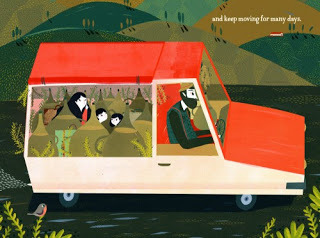 Keep moving, from The Journey by Francesca SannaAfter the book was published, The Journey had its own journey. I had the wonderful opportunity to meet an incredible community of librarians, teachers, activists, and most importantly readers. I went around schools in different countries (Spain, Austria, UK, Italy, Germany and Switzerland) and saw the reaction to the book I wrote, discussing it with children and teachers.
Keep moving, from The Journey by Francesca SannaAfter the book was published, The Journey had its own journey. I had the wonderful opportunity to meet an incredible community of librarians, teachers, activists, and most importantly readers. I went around schools in different countries (Spain, Austria, UK, Italy, Germany and Switzerland) and saw the reaction to the book I wrote, discussing it with children and teachers.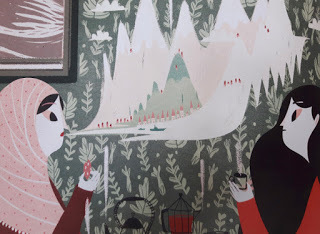 Stories of escape, from The Journey by Francesca Sanna
Stories of escape, from The Journey by Francesca SannaThe reactions to my open-and-maybe-not-so-happy ending were varied, as were the general responses to the book in every class and every school. Sometimes, when I read the story, I would finish reading the last lines and then I would have to say “and this was the last page of the book”. Normally this moment is followed by surprised gazes and a few whispered “What???”. Some of the children like the idea of different possible ways of ending the story on their own, while some hate the concept of a journey that does not reach the destination.
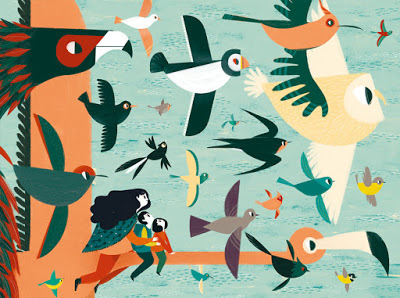 Migrating birds. Final image from The Journey by Francesca SannaBack at the beginning, my idea of a blank ending was more a symbolic idea, to leave to parents or teachers the space for a discussion with their children about what happens next. Later I took it more literally with workshops where children completed the story however they wanted. I'd read the story, discussing some pages and the choices I made when writing and illustrating the story. Then I'd answer all their question until finally I'd ask them one question: how would you end the story?
Migrating birds. Final image from The Journey by Francesca SannaBack at the beginning, my idea of a blank ending was more a symbolic idea, to leave to parents or teachers the space for a discussion with their children about what happens next. Later I took it more literally with workshops where children completed the story however they wanted. I'd read the story, discussing some pages and the choices I made when writing and illustrating the story. Then I'd answer all their question until finally I'd ask them one question: how would you end the story?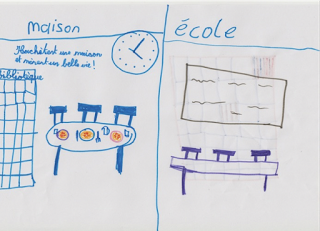 “They buy a house and have a beautiful life!” An ending by Saphir, 7 years old
“They buy a house and have a beautiful life!” An ending by Saphir, 7 years old 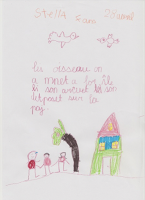
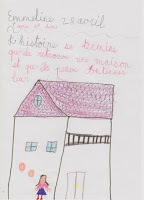
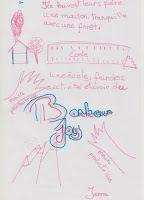
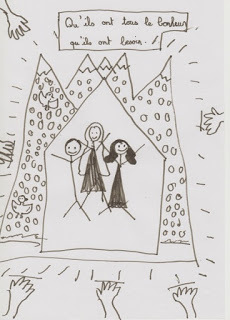 Drawing from a reading at the City Library of Geneva (Switzerland)
Drawing from a reading at the City Library of Geneva (Switzerland) with children from Year 1 to Year 4
Further information
Amnesty International useful classroom resources on The Journey pdf
The Klaus Flugge Prize
Francesca Sanna website
Published on January 07, 2018 23:30
December 30, 2017
Our picture books - our favourites
In schools we’re often asked to pick our personal favourite picture book out of all the books we’ve written or illustrated. This is a tricky question.
A favourite might be our newest book because that’s still our baby. Or it could be the one we feel is the best quality, whatever that means. Or maybe it’s the book that has made us the most money. Or there could be a secret, emotional attachment to a book that only we know about.
So to start the New Year, six of us at the Picture Book Den thought we’d try and answer this tricky question. We’ve only allowed ourselves one book each, argh! Here are the personal favourite picture books of Jane Clarke, Jonathan Emmett, Pippa Goodhart, Paeony Lewis, Garry Parsons, and Lucy Rowland.
Jane Clarke
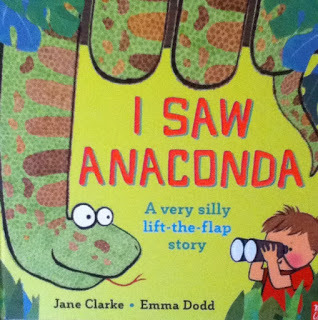
My personal favourite has to be I Saw Anaconda, illustrated by Emma Dodd (Nosy Crow, 2016)
The rhyme popped into my head on a once-in-a-lifetime adventure tour in Venezuela in 2008, and will always remind me of it. One of my sons was working there as a tour guide, and he took me and his brother to find anaconda. The rhyme took 9 years (and many rejections) before a publisher (Nosy Crow) worked out what to do with it. It was wonderful to be able to dedicate it to both my sons who now have families of their own. I saw anaconda has fab illustrations and clever flaps that include a pull-out snake. My four young granddaughters (including two who are part-Venezuelan) have already chewed/ torn/ generally loved to death several copies :-)
Jonathan Emmett
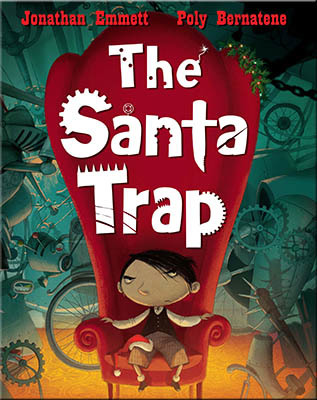
My favourite self-penned picture book is The Santa Trap, illustrated by Poly Bernatene (Macmillan, 2009). It tells the story of Bradley Bartleby, an obscenely rich, villainous child who sets out to trap Santa Claus so that he can steal all of Santa's presents. One of the reasons I'm particularly fond of the book is that it's slightly autobiographical; as a child I used to build Santa traps. However, unlike Bradley, I didn't want to capture Santa and steal his presents – I just wanted to get a glimpse of him. So the traps I built were designed to wake me up the moment Santa set foot in my room.
Another reason I'm particularly fond of it is Poly's wonderful illustrations. The story was quickly taken by a publisher, but it took three years to find a suitable illustrator. A couple of illustrators agreed to do it but then changed their minds. Eventually editor Emily Ford found Poly and asked him to do a sample. He turned out to be a perfect fit and well worth the wait. Poly and I have since done another three books together.
Pippa Goodhart
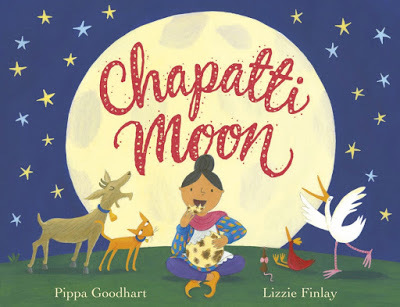
I've got a new favourite book of mine, and its Chapatti Moon (Tamarind, 2017). Why? Well, I love the pictures that Lizzie Findlay has done of Mrs Kapoor and the animals as they chase the chapatti that's rolled away. I love the clever design that includes a twist of the book to make you look up when the chapatti goes up into the sky. But I'm also proud of my text that ends as she saw ...' her chapatti moon slip-sliding down the sky. She held out her hands, and she caught it. "I shall eat the moon!" said Mrs Kapoor. It was just enough. She wanted not more. And it did taste wonderfully moony.' Next time you eat a chapatti, consider that thought. I suspect you'll also find that it tastes 'moony'!
Paeony Lewis
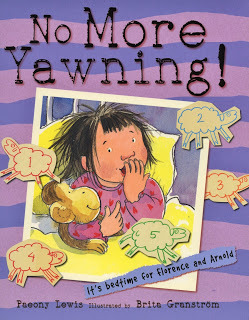
In monetary terms, there’s no way my favourite book could be No More Yawning (Chicken House/Scholastic, 2008). Instead it’s an old favourite for making me smile the most. It’s about a little girl, Florence, and her toy monkey, Arnold, and their bedtime antics.
We British are often reticent about blowing our own horn, but I do like the feisty ‘first person’ voice of Florence and the way the story builds. Plus now that I know more about art I appreciate further the fluid watercolour illustrations by Brita Granstrom. And I like the end papers and the spot varnish on the cover (little things make me happy!).
I particularly enjoy reading No More Yawning in schools because when Florence yawns, the young children join in too. Unfortunately, it’s embarrassing when outside the classroom I overhear children laughing and saying they yawned a lot in storytime – I feel compelled to explain to others the yawning WASN'T because the story was boring (really!).
I also like that the story encourages children to make up their own stories before they go to sleep. However, all this isn’t quite enough to make No More Yawning my favourite. What helps most is that my daughter was the inspiration for the story and it brings back memories, even if many years ago those bedtimes were frequently frustrating!
I think that’s enough reasons. Though it has to be the hardback version with the lovely endpapers.
Garry Parsons
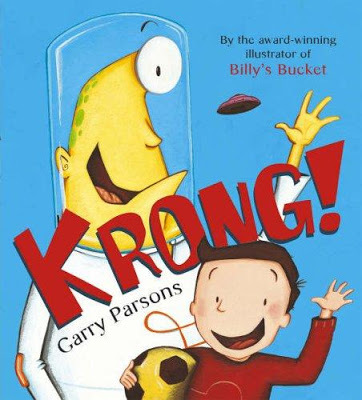
When school children ask which of my books is my favourite I almost always say it’s my latest publication but then inevitably I revert back to Krong! (The Bodley Head, 2005).
In the story, Carl is playing in his garden when a spaceship lands and out steps an alien and his alien dog. Carl tries a succession of languages to try to communicate with the Alien who only speaks 'Noobanese'. Eventually the puzzle is solved but there’s also an identity twist.
What I like about this book is that it almost certainly requires you to look back through the illustrations to spot the clues you would have missed on the first reading. Looking back and studying the illustrations was something I enjoyed as a boy, particularly in a book called What-a-Mess by Frank Muir and illustrated by Joseph Wright, where you can spot an entirely separate narrative going on alongside the main story. I also love that so much of the detail in Krong!is based on things that were pertinent or existed in my life at the time, including the two dogs, quite a lot of the furniture and that I was having lessons in Japanese.
Lucy Rowland
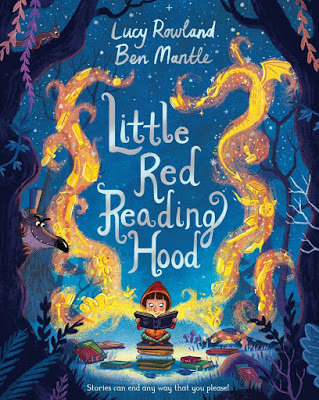
My favourite picture book that I have written is Little Red Reading Hood illustrated by the rather wonderful Ben Mantle. Ben's illustrations bring this whole story to life. They are so utterly magical and beautiful!..I mean, just look at that cover!! But, for me, even before I saw Ben's artwork, this was a story that I loved and believed in. It was one of those stories that wrote itself, one cold grey Sunday a few years ago. My agent believed in it instantly and so too did my editor, Laura Roberts. Little Red Reading Hood is (hopefully) a celebration of story, a celebration of reading and of the power of imagination. It is also, importantly, a celebration of libraries. (Plus it includes one of my favourite self-penned rhymes...)
'Meanwhile at the library, what a barbarian!
Wolf had tied up Mrs Jones, the librarian!'
Little Red Reading Hood publishes with Macmillan on 25th January 2018 (Eeeek! Not long to go!) and I really hope that people enjoy reading it as much as I enjoyed dreaming it up.
______
So those are our six favourites. Have any choices surprised you? Some books are old, some are new, and they're not necessarily our top sellers, but we love them for our own reasons.
A favourite might be our newest book because that’s still our baby. Or it could be the one we feel is the best quality, whatever that means. Or maybe it’s the book that has made us the most money. Or there could be a secret, emotional attachment to a book that only we know about.
So to start the New Year, six of us at the Picture Book Den thought we’d try and answer this tricky question. We’ve only allowed ourselves one book each, argh! Here are the personal favourite picture books of Jane Clarke, Jonathan Emmett, Pippa Goodhart, Paeony Lewis, Garry Parsons, and Lucy Rowland.
Jane Clarke

My personal favourite has to be I Saw Anaconda, illustrated by Emma Dodd (Nosy Crow, 2016)
The rhyme popped into my head on a once-in-a-lifetime adventure tour in Venezuela in 2008, and will always remind me of it. One of my sons was working there as a tour guide, and he took me and his brother to find anaconda. The rhyme took 9 years (and many rejections) before a publisher (Nosy Crow) worked out what to do with it. It was wonderful to be able to dedicate it to both my sons who now have families of their own. I saw anaconda has fab illustrations and clever flaps that include a pull-out snake. My four young granddaughters (including two who are part-Venezuelan) have already chewed/ torn/ generally loved to death several copies :-)
Jonathan Emmett

My favourite self-penned picture book is The Santa Trap, illustrated by Poly Bernatene (Macmillan, 2009). It tells the story of Bradley Bartleby, an obscenely rich, villainous child who sets out to trap Santa Claus so that he can steal all of Santa's presents. One of the reasons I'm particularly fond of the book is that it's slightly autobiographical; as a child I used to build Santa traps. However, unlike Bradley, I didn't want to capture Santa and steal his presents – I just wanted to get a glimpse of him. So the traps I built were designed to wake me up the moment Santa set foot in my room.
Another reason I'm particularly fond of it is Poly's wonderful illustrations. The story was quickly taken by a publisher, but it took three years to find a suitable illustrator. A couple of illustrators agreed to do it but then changed their minds. Eventually editor Emily Ford found Poly and asked him to do a sample. He turned out to be a perfect fit and well worth the wait. Poly and I have since done another three books together.
Pippa Goodhart

I've got a new favourite book of mine, and its Chapatti Moon (Tamarind, 2017). Why? Well, I love the pictures that Lizzie Findlay has done of Mrs Kapoor and the animals as they chase the chapatti that's rolled away. I love the clever design that includes a twist of the book to make you look up when the chapatti goes up into the sky. But I'm also proud of my text that ends as she saw ...' her chapatti moon slip-sliding down the sky. She held out her hands, and she caught it. "I shall eat the moon!" said Mrs Kapoor. It was just enough. She wanted not more. And it did taste wonderfully moony.' Next time you eat a chapatti, consider that thought. I suspect you'll also find that it tastes 'moony'!
Paeony Lewis

In monetary terms, there’s no way my favourite book could be No More Yawning (Chicken House/Scholastic, 2008). Instead it’s an old favourite for making me smile the most. It’s about a little girl, Florence, and her toy monkey, Arnold, and their bedtime antics.
We British are often reticent about blowing our own horn, but I do like the feisty ‘first person’ voice of Florence and the way the story builds. Plus now that I know more about art I appreciate further the fluid watercolour illustrations by Brita Granstrom. And I like the end papers and the spot varnish on the cover (little things make me happy!).
I particularly enjoy reading No More Yawning in schools because when Florence yawns, the young children join in too. Unfortunately, it’s embarrassing when outside the classroom I overhear children laughing and saying they yawned a lot in storytime – I feel compelled to explain to others the yawning WASN'T because the story was boring (really!).
I also like that the story encourages children to make up their own stories before they go to sleep. However, all this isn’t quite enough to make No More Yawning my favourite. What helps most is that my daughter was the inspiration for the story and it brings back memories, even if many years ago those bedtimes were frequently frustrating!
I think that’s enough reasons. Though it has to be the hardback version with the lovely endpapers.
Garry Parsons

When school children ask which of my books is my favourite I almost always say it’s my latest publication but then inevitably I revert back to Krong! (The Bodley Head, 2005).
In the story, Carl is playing in his garden when a spaceship lands and out steps an alien and his alien dog. Carl tries a succession of languages to try to communicate with the Alien who only speaks 'Noobanese'. Eventually the puzzle is solved but there’s also an identity twist.
What I like about this book is that it almost certainly requires you to look back through the illustrations to spot the clues you would have missed on the first reading. Looking back and studying the illustrations was something I enjoyed as a boy, particularly in a book called What-a-Mess by Frank Muir and illustrated by Joseph Wright, where you can spot an entirely separate narrative going on alongside the main story. I also love that so much of the detail in Krong!is based on things that were pertinent or existed in my life at the time, including the two dogs, quite a lot of the furniture and that I was having lessons in Japanese.
Lucy Rowland

My favourite picture book that I have written is Little Red Reading Hood illustrated by the rather wonderful Ben Mantle. Ben's illustrations bring this whole story to life. They are so utterly magical and beautiful!..I mean, just look at that cover!! But, for me, even before I saw Ben's artwork, this was a story that I loved and believed in. It was one of those stories that wrote itself, one cold grey Sunday a few years ago. My agent believed in it instantly and so too did my editor, Laura Roberts. Little Red Reading Hood is (hopefully) a celebration of story, a celebration of reading and of the power of imagination. It is also, importantly, a celebration of libraries. (Plus it includes one of my favourite self-penned rhymes...)
'Meanwhile at the library, what a barbarian!
Wolf had tied up Mrs Jones, the librarian!'
Little Red Reading Hood publishes with Macmillan on 25th January 2018 (Eeeek! Not long to go!) and I really hope that people enjoy reading it as much as I enjoyed dreaming it up.
______
So those are our six favourites. Have any choices surprised you? Some books are old, some are new, and they're not necessarily our top sellers, but we love them for our own reasons.
Published on December 30, 2017 13:06
December 17, 2017
Missing Vowels Christmas Picture Book Puzzler • Jonathan Emmett
Following on from previous Christmas Quizzes in 2015 and 2016, here's another set of picture book puzzles for you to solve. This year I've taken my inspiration from the "Missing Vowels" round of BBC quiz show
Only Connect
. For those unfamiliar with the show, I've taken the titles of ten classic picture books, removed all of the vowels and punctuation marks and changed the spaces between the words. For example, THE GRUFFALO might be changed into as THG RF FL.
How many ‘disemvowelled’ book titles can you recognise? Click on each image to reveal the answer. To make things more Christmassy – there's a festive theme to the even-numbered titles.
1.

2.

3.

4.

5.

6.

7.

8.

9.

10.

How did you do?
10 O for outstanding: Your knowledge of picture book titles is exemplary! 7–9 A for advanced: A good effort. You know your Child from your Chichester Clark. 4–6 I for intermediate: Not bad, but perhaps you should add a few picture book classics to your Christmas list. 1–3 U for ungraded: A disappointingly Gruffa-low score. You need to brush up on your picture book knowledge.
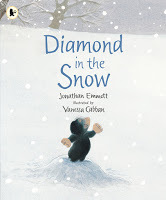 Jonathan Emmett's sparkling seasonal story Diamond in the Snow, illustrated by Vanessa Cabban, has just been re-published in a new edition from Walker Books.
Jonathan Emmett's sparkling seasonal story Diamond in the Snow, illustrated by Vanessa Cabban, has just been re-published in a new edition from Walker Books.
Find out more about Jonathan and his books at his Scribble Street web site or his blog. You can also follow Jonathan on Facebook and Twitter @scribblestreet.
See all of Jonathan's posts for Picture Book Den.
How many ‘disemvowelled’ book titles can you recognise? Click on each image to reveal the answer. To make things more Christmassy – there's a festive theme to the even-numbered titles.
1.

2.

3.

4.

5.

6.

7.

8.

9.

10.

How did you do?
10 O for outstanding: Your knowledge of picture book titles is exemplary! 7–9 A for advanced: A good effort. You know your Child from your Chichester Clark. 4–6 I for intermediate: Not bad, but perhaps you should add a few picture book classics to your Christmas list. 1–3 U for ungraded: A disappointingly Gruffa-low score. You need to brush up on your picture book knowledge.
 Jonathan Emmett's sparkling seasonal story Diamond in the Snow, illustrated by Vanessa Cabban, has just been re-published in a new edition from Walker Books.
Jonathan Emmett's sparkling seasonal story Diamond in the Snow, illustrated by Vanessa Cabban, has just been re-published in a new edition from Walker Books.Find out more about Jonathan and his books at his Scribble Street web site or his blog. You can also follow Jonathan on Facebook and Twitter @scribblestreet.
See all of Jonathan's posts for Picture Book Den.
Published on December 17, 2017 23:51
Missing Vowels Christmas Picture Book Puzzler
Following on from previous Christmas Quizzes in 2015 and 2016, here's another set of picture book puzzles for you to solve. This year I've taken my inspiration from the "Missing Vowels" round of BBC quiz show
Only Connect
. For those unfamiliar with the show, I've taken the titles of ten classic picture books, removed all of the vowels and punctuation marks and changed the spaces between the words. For example, THE GRUFFALO might be changed into as THG RF FL.
How many ‘disemvowelled’ book titles can you recognise? Click on each image to reveal the answer. To make things more Christmassy – there's a festive theme to the even-numbered titles.
1.

2.

3.

4.

5.

6.

7.

8.

9.

10.

How did you do?
10 O for outstanding: Your knowledge of picture book titles is exemplary! 7–9 A for advanced: A good effort. You know your Child from your Chichester Clark. 4–6 I for intermediate: Not bad, but perhaps you should add a few picture book classics to your Christmas list. 1–3 U for ungraded: A disappointingly Gruffa-low score. You need to brush up on your picture book knowledge.
 Jonathan Emmett's sparkling seasonal story Diamond in the Snow, illustrated by Vanessa Cabban, has just been re-published in a new edition from Walker Books.
Jonathan Emmett's sparkling seasonal story Diamond in the Snow, illustrated by Vanessa Cabban, has just been re-published in a new edition from Walker Books.
Find out more about Jonathan and his books at his Scribble Street web site or his blog. You can also follow Jonathan on Facebook and Twitter @scribblestreet.
See all of Jonathan's posts for Picture Book Den.
How many ‘disemvowelled’ book titles can you recognise? Click on each image to reveal the answer. To make things more Christmassy – there's a festive theme to the even-numbered titles.
1.

2.

3.

4.

5.

6.

7.

8.

9.

10.

How did you do?
10 O for outstanding: Your knowledge of picture book titles is exemplary! 7–9 A for advanced: A good effort. You know your Child from your Chichester Clark. 4–6 I for intermediate: Not bad, but perhaps you should add a few picture book classics to your Christmas list. 1–3 U for ungraded: A disappointingly Gruffa-low score. You need to brush up on your picture book knowledge.
 Jonathan Emmett's sparkling seasonal story Diamond in the Snow, illustrated by Vanessa Cabban, has just been re-published in a new edition from Walker Books.
Jonathan Emmett's sparkling seasonal story Diamond in the Snow, illustrated by Vanessa Cabban, has just been re-published in a new edition from Walker Books.Find out more about Jonathan and his books at his Scribble Street web site or his blog. You can also follow Jonathan on Facebook and Twitter @scribblestreet.
See all of Jonathan's posts for Picture Book Den.
Published on December 17, 2017 23:51
December 10, 2017
Giving It A Twist, by Pippa Goodhart
In my new picture book, Chapatti Moon, illustrated by Lizzie Finlay, I did something that writers get told not to do. I added a design note to say, 'Could the next spread involve twisting the book to see the illustration in portrait rather than landscape/' Why did I want that? Because the story involved the runaway chapatti being kicked up into the sky by a donkey, and I wanted the audience's eyes to look up in the same way as Mrs Kapoor does. So we go from -
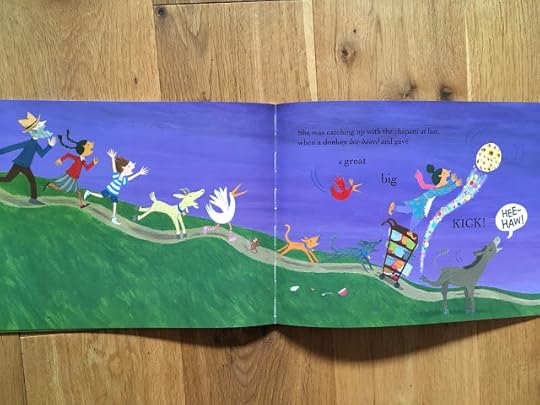
...to ...

I'm not the first to have used that trick in a picture book by any means, and that thought set me looking for other examples.
This Is Not A Book by Jean Jullien uses the fold half way down the book on portrait to brilliant advantage, turning the book into a chair -
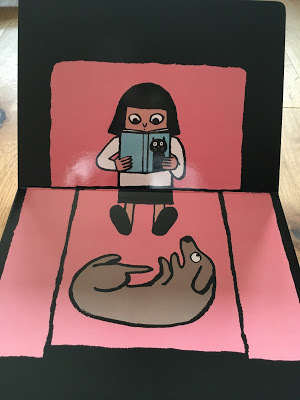
Or a computer -
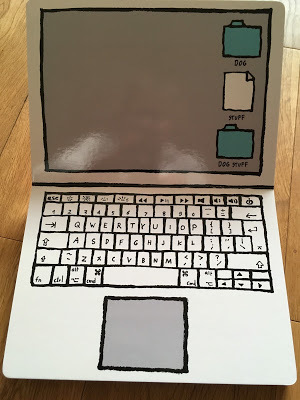
Other books use that format with different purpose. Emily Gravett's The Rabbit Problem makes the whole book a calendar which could be hung just like a real one -
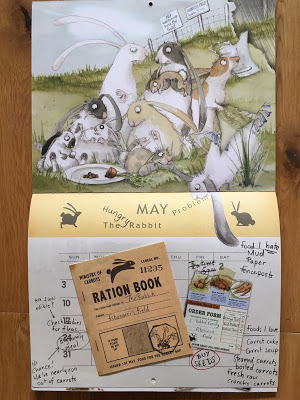
And, another of my favourite picture books, Tadpole's Promise, written by Jeanne Willis and illustrated by Tony Ross, uses that horizontal gutter as the divide between water and air.
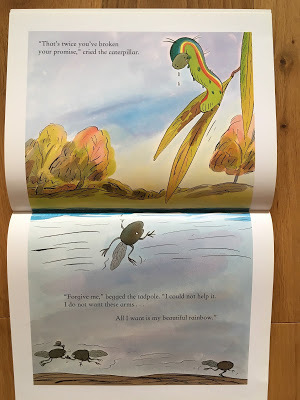
The problem with that idea is that the story action happens very much at the meeting place between those two elements, and so the main point of interest is sometimes a bit lost in the fold.
Do you know of other examples that use this book orientation to a particular purpose? Or can you think of one that might work well in a book?

...to ...

I'm not the first to have used that trick in a picture book by any means, and that thought set me looking for other examples.
This Is Not A Book by Jean Jullien uses the fold half way down the book on portrait to brilliant advantage, turning the book into a chair -

Or a computer -

Other books use that format with different purpose. Emily Gravett's The Rabbit Problem makes the whole book a calendar which could be hung just like a real one -

And, another of my favourite picture books, Tadpole's Promise, written by Jeanne Willis and illustrated by Tony Ross, uses that horizontal gutter as the divide between water and air.

The problem with that idea is that the story action happens very much at the meeting place between those two elements, and so the main point of interest is sometimes a bit lost in the fold.
Do you know of other examples that use this book orientation to a particular purpose? Or can you think of one that might work well in a book?
Published on December 10, 2017 16:30



